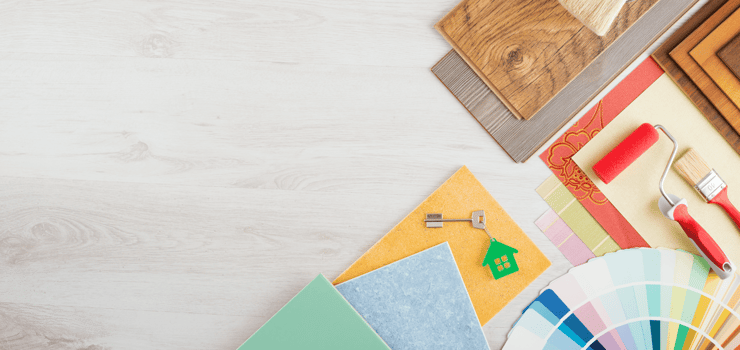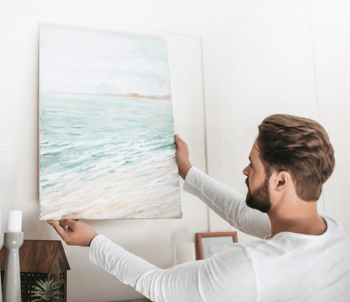 You don't have to be a master decorator to jazz up your living room or bedroom.
You don't have to be a master decorator to jazz up your living room or bedroom.
In fact, with these interior design secrets, you can have a magazine-style home in no time at all.
Just don't tell anyone we told you!
1. Take Advantage of Natural Light
Don't cover your windows with thick, heavy drapes. Let the glass be a prominent feature in the room, especially if you have gorgeous architectural elements like bay windows or awning windows. These are features to be showcased for both their aesthetic value and their cat-attracting qualities.
2. Upholster Your Furniture
This is a great way to reuse beloved pieces of furniture no matter what style you're currently rocking with your interior design. Simply replace the upholstery with something that suits the colours or patterns of your new theme. It's quick, easy and non-permanent.
 3. Hang Everything at the Right Height
3. Hang Everything at the Right Height
Maybe you have a family portrait above the fireplace. Maybe you've decorated your den with the work of eclectic local artists. No matter what pieces are hanging on your walls, try to put them at the height of the human eye. This is a trick used by museums and art galleries to attract attention.
4. Decorate Around a Theme
Speaking of themes, it's important to have one before designing any room project. It can be as basic as "beige tones in the bathroom" to nail the neutral look, or as complicated as "wicker furniture emphasizing the nautical theme of the kids' pirate playroom." Just give yourself some kind of thematic springboard for all of your decorating ideas.
5. Evoke Symmetry
Humans are pleased by symmetrical designs on a basic, fundamental level, so don't be afraid to pair up your bedside tables or arrange your lamps in a parallel fashion. You can also play around with asymmetrical designs if you want something off-beat, but be careful not to overdo it!
6. Make Your Space Feel Bigger
On a structural scale, making a small space feel bigger can be accomplished with open-air floor plans and lots of windows. On a design scale, don't stuff the room with furniture or use dark, oppressive colours that make everything feel stuffy.
7. Create Leading Lines
Leading lines are lines that naturally draw the eye from the foreground to the background. They're quite popular in photography, but few people realize they can be utilized in home design, too. Create these leading lines with your art, furniture, and rugs to lead your visitors through your home with flowing ease.
 8. Use Complementary Colours
8. Use Complementary Colours
This applies to doors, windows, rugs, carpets, bedspreads, and even the walls themselves. Everything looks better when you use multiple complementary shades instead of one uniform colour scheme. Think about perfect paint pairings like blue and gray, pink and green, teal and orange, and so on.
9. Have a Focal Point
Is there a big, dominant feature in the room that you can play off when choosing fabrics and paint hues? It might be a couch, fireplace, dining room table, or lounge chair in your master bedroom. The specifics don't matter as long as you decorate around them as a central element in your interior design.
10. Improve Your Organization
If you've put off your spring cleaning, it's time to buckle down and get it done! Don't groan. It's good for you. Not only will you make your home feel less cluttered when you finally sort out your knick-knacks, but better organization will also create open spaces to maximize your storage space. Going forward, a home cleaning schedule for your busy family can help with this upkeep.
11. Think About Texture
Texture is often ignored in favour of other design elements like colour and size, but it can really add a sense of personality to the room. For example, fuzzy toilet covers will make the bathroom feel like a friendly place, and gritty sand art in the guest room will pull together your beach theme.
12. Create Natural Pathways and Walkways
It's about more than just elbow room. You want your interior design to take your visitors on a journey, and this means subtly encouraging them to walk down certain paths. Rearrange your armchairs, footstools, and storage trunks until you have a nice walkway.
13. Play Around With Shelving
Two or three shelves can be arranged in a dozen different ways, so try not to box yourself in with a conventional "one above the other" design. Arrange them in an X- or T-shape instead. Space them out in unusual patterns. Create a jigsaw puzzle on your walls – getting creative with these sorts of setups can even give you more storage space.
14. Reflect Your Surroundings
Mirrors are a great design element to introduce to your home. In addition to making small rooms feel bigger, they'll also reflect sunshine from your windows and patio doors. You'll get a boost of natural light without having to knock down a single wall.
15. Get Steely
Stainless steel is most common in bathrooms and kitchens, but it can be incorporated into the rest of your home as well. Think about steel accents around your high-tech home entertainment centre or steel tables emphasizing a sleek, modern living room.
16. Don't Forget the Ceiling
Ceilings can be neglected when it comes to home design, but you can do a lot with all of that space just hanging around overhead. For example, you can install extra lights to increase the scale and depth of the room, or you can attach hooks for hanging baskets of flowers.
These are just a few tips and tricks that can add style to any room. Whether you're moving into a new home or redecorating the one you already have, let these ideas serve as a springboard for further interior design inspiration.





